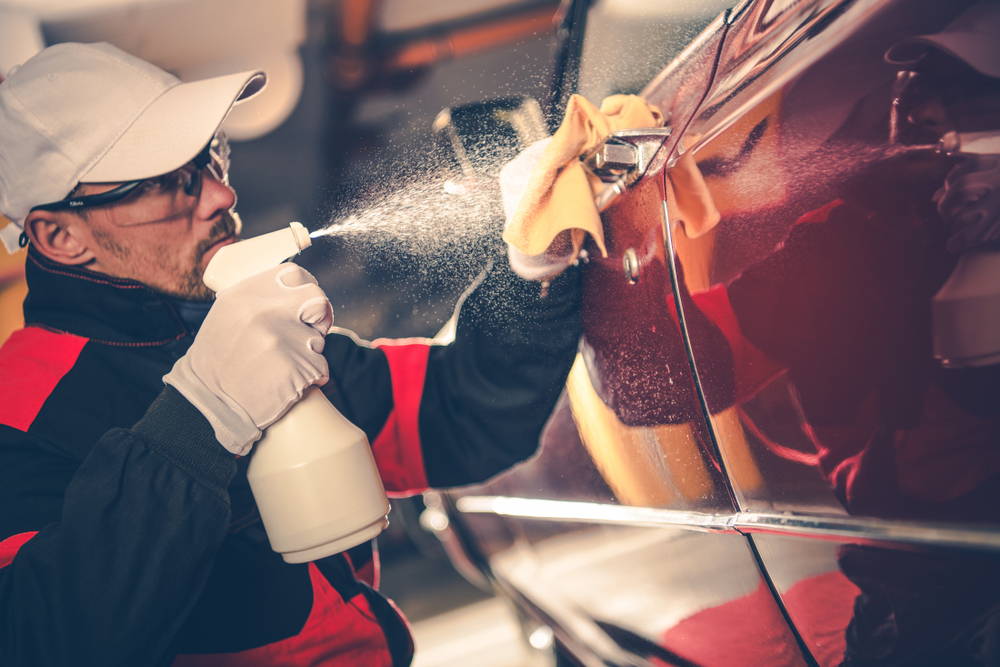If you’re reading this article, you’re probably considering applying a ceramic coating on your car.
They provide phenomenal, long-lasting protection to your paint from UV degradation and chemical erosion - bird droppings, tree sap, acid rain, and others. The coating can even absorb light mechanical damage and fine abrasion from dust, dirt, and salt, though the paint can still get scratched or smashed by flying rocks. Of course, it’s not a bed liner, so don’t expect miracles. But most of all, ceramic coatings produce a hydrophobic surface that sheds water on its own, prevents pretty much anything from sticking, and leaves a super sleek, high-gloss finish.
There’s nothing more effective and durable in the car care world than a professionally applied nano-ceramic coating. However, do you want to spend $500-$1,000 to get your car coated by a professional detailer? Of course not. You can just buy a $50 bottle and does it out in your driveway, right? Wrong! It’s called detailing for a reason.
★★★★★ "My car is slick as glass!! I put the Ceramic Spray on my Corvette Stingray and it is very slick and shiny. I should have purchased it sooner. It is a great product. It made my wheels look new. Keeps off dirt and dust." - Charlie F.
Ceramic Coating Gone Wrong - The Top 3 Fails on the Internet!
Speaking of YouTube videos, we’ve got a fine selection of ceramic coating fails.
We really need to thank all these fellows for their bravery in uploading their (or other detailers’) mistakes online so we can learn from and not repeat them.
If you don’t fall under the same mistakes, put in the effort, do it smart, and take your time. You’ll then see great results although ceramic coating a car takes practice.
Fail #1: Anthony from AltcoinXP's BMW M2
Problem: Bad streaks and marks, horrible reflections
Mistake: Not wiping the ceramic coating off after application
Anthony didn’t research the proper installation procedures for the product he purchased. He applied two coats of ceramic on his BMW M2 without wiping any of it. The excess that flashed off simply baked on top of the surface and left horrible streaks and marks where the applicator left the thickest layer.
Fail #2: Ceramic Coating Fail Rolled Into Wicked Auto Protection's Shop
Problem: Horrible applicator marks and streaks similar to a brushed finish, definitely not clear
Mistake: Trusting his friend to do the ceramic coating
Sam from Wicked Auto Protection got this BMW which was ceramic coated by the customer’s friend. They applied the coating and likewise didn’t wipe any of it. As a result, the paint is absolutely caked in ceramic frosting.
Sam admits that the only way to remove it is sanding with 1500-grit sandpaper, after which the vehicle needs to be polished before reapplying the coating. According to his estimate, the repair cost is $5,000.
Do you want to spend the $500 now?
Fail #3: Client Bought Shoddy Ceramic Coating Job. Deadeye Detailing to the Rescue!
Problem: Ceramic coating is completely ineffective
Mistake: Paying a shoddy dealership to install a product of unknown quality
This story comes from the UK, where a customer paid £1,200 (nearly $1,600) to a local car dealer for a ceramic coating on their vehicle. You see the result - there are absolutely no hydrophobic properties. The coating is either completely compromised or has never been applied in the first place.
Hey, A Traditional Ceramic Coating Can Be Tricky - That's One Reason We Invented Ceramic Spray
Traditional ceramic coatings are amazing products. They offer unmatched protection and durability to your paint. However, they’re also not designed for DIY applications. There’s lots of places to go wrong and ruin the finish of your vehicle.
If you want to do your own coating but don’t have any experience, we strongly advise you to look into ceramic coating sprays like Ceramic Spray by Torque Detail.
This product is a hybrid coating that contains both polymer chains and ceramic particles. The result is an easy-to-use formula that gives you the control and flexibility of paint sealants as well as the effectiveness and durability of ceramic coatings.
Sure, it doesn’t last just as long as the traditional ceramic coating. However, you still get up to 12 months from it at a cheaper price, and it’s super easy to apply and reapply on your own.
Is Applying A Ceramic Coating Difficult?
For all their amazing properties, ceramic coatings are a double-edged sword.
They look deceptively easy to apply. Put a few droplets on the applicator, rub it in the panel, leave it for a few minutes to flash, and wipe off with a microfiber cloth. It seems a simple enough process.
However, there are many variables to achieving a great-looking finish.
It’s easy to use too much or too little product. It’s easy to not apply it evenly over the panel, missing a few spots or leaving others too rich.
The flashing time will also vary significantly depending on the product, temperature, and humidity of your surroundings.
The biggest drawback of ceramic coatings is they are uncompromising. Once you start working, there’s no margin for error and little chance to correct your mistakes as you go.
Ceramic coatings can’t damage your paint, regardless of what you do. However, improper application can leave streaks, high spots, hazing, and horrible reflections. So you’d better know what you’re doing, because once this thing sets, it cements over your paint for the next couple of years.
Moreover, if you haven’t spent at least half a day meticulously cleaning and polishing your paint, well, too bad. Every scratch, swirl mark, hazing, or other imperfection will be locked in for the lifetime of the coating.
The only way you can remove a ceramic coating after it has cured is to bust out the sandpaper and sand, then polish, then finish the whole car. We’re talking several days of grinding away at the coating to strip the car down to clear and start over from square one.
The Secrets To A Professional-Level Ceramic Coating
Okay, we’re not going to pretend ceramic coatings are rocket science.
You absolutely CAN DIY ceramic coatings on your cars. However, you should heed these professional tips and make sure to put in the necessary time and effort.
Secret 1: Preparation and paint correction
The hardest part of applying ceramic coatings is the prep work. This is 75%-90% of the work, regardless of whether you’re doing it in the garage or have taken the car to a detailing shop.
At the bare minimum, a respectable detailer will wash your car, decontaminate it, perform a clay bar pass (claying), and finally, perform a polish and finishing operation with an automatic machine. All of this needs to happen in a very clean room with appropriate lighting.
All dirt, brake dust, mineral deposits, salts, bio waste, and other contamination must be 100% removed. Any car, regardless of whether it has just come out of the factory or has been sitting in the driveway for six months, will have collected some grime.
The amount of polishing and paint correction necessary depends on the condition of your clear coat. However, you should acknowledge that any imperfection you leave will be locked in for good after applying the ceramic coating.
Secret 2: Controlling your motions
The key to great ceramic coating is consistent and even application - and the key to consistent and even application is controlling your motions as you apply the product.
You don’t want to move the applicator all over the place. If you can’t control the motion, you can’t control the consistency of the product that goes into the different areas of the panel.
You want to move in a square snake pattern, covering the entire surface. Then, you want to go 90 degrees and cross-hatch the panel, evenly spreading out the product. You need to keep the applicator on the panel at all times with consistent pressure.
When you go back to buff it, it’s time to use circular motions with light pressure. This way, you’re not pushing the product in either direction and causing high spots.
It’s best to use a second towel and wipe the panel again to ensure all the excess is off and the surface of the coating is as level as possible.
Secret 3: One panel at a time
Any professional detailer knows they need to work on one panel at a time - apply the product, wait for it to flash, buff it out, then move onto the next panel. In doing this, you limit the chances of forgetting a step or not completely or evenly covering the entire surface.
Some ceramic coatings need to come out after just a minute of application. If you’re working on the entire front end, you’ll lose track of where you’ve started and how soon you need to wipe down.
That’s a classic recipe for disaster.
Secret 4: Test-run
Professional detailers can apply a ceramic coating on the whole car in one go (still one panel at a time). They have the experience to know and predict what the product will do in different scenarios.
You don’t.
If you’re doing your own coating for the first time, you should most definitely test it first on an inconspicuous place on your vehicle. This means going through the entire procedure, but just for the valence panel, for example.
Do a diligent job and leave it to cure for 24 hours or the manufacturer’s recommended timeframe. Then, inspect and analyze the results.
Does it look great? Super glossy finish, clear reflections, and slippery-smooth to the touch? No high spots, marks, streaks, or hazing? How about hydrophobic and non-stick properties?
If the answer is yes to all of these, you’re good to go on a bigger panel such as the hood. If the results are good again, you can finish off the rest of the car with confidence that you’ll get the results you expected.
On the other hand, doing the car in a single go with no previous experience is asking for trouble - no matter how many YouTube videos you’ve seen.







